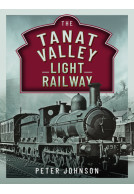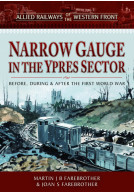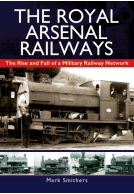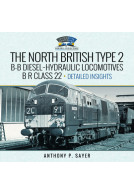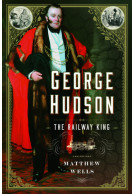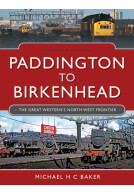The Welshpool & Llanfair Light Railway (ePub)
The Story of a Welsh Rural Byway
Imprint: Pen & Sword Transport
Series: Narrow Gauge Railways
File Size: 112.2 MB (.epub)
Pages: 232
Illustrations: 200 colour & black and white illustrations, maps and track diagrams
ISBN: 9781526744784
Published: 7th August 2020
Unusually among Welsh narrow-gauge railways, the 2ft 6in gauge Welshpool & Llanfair Light Railway was built to benefit agriculture, not minerals. After several failed attempts to connect the market town at Welshpool with the rural community around Llanfair Caereinion, the 1896 Light Railways Act paved the way for the railway which opened in 1902.
Operated by the Cambrian Railways and then by the Great Western Railway it became the only narrow-gauge steam railway catering for goods traffic under the auspices of British Railways. Sadly, it was closed in 1956 but enthusiasts ensured its revival, which started in 1963.
Overcoming many obstacles, the railway is now run by a charitable trust and is a leading volunteer-operated tourist attraction in Montgomeryshire.
If you are interested in Welsh narrow gauge lines, want to model them or just want to read a railway book that is a bit different, then this volume ought to be on your bookshelf. Just dip in anywhere - and I don't think that you will be disappointed!
Great Western Study Group's Newsletter - Winter 2022
This book, from prolific author Peter Johnson, is one of the latest from local publishers Pen and Sword. It is a large format hardback book with dust jacket, running to 232 pages, and printed throughout in heavy quality gloss paper. Inside the front and rear covers can be found excellent maps of the complete line, together with gradient profiles.
Phillip Lockwood, Bradford Railway Circle
The book is an exhaustive and well researched history of the line from inception through to the preservation age. It's clear that Peter looks at the development from an historian's viewpoint, covering many of the earliest records from the Cambrian Railway through the Great Western Railway to the BR period and finally to the preservation railway era.
This is definitely not just a book of pictures, as there is so much additional information. It is profusely illustrated with a good selection of excellent quality colour photographs, mostly from the camera of Peter himself. There are historical pictures aplenty, most of which I have not seen in print previously. Many are delightful period colour images. The locomotive and rolling stock pictures give a good view of the different locomotives that have worked on the line over the years. Many were visitors, whilst others have been used in the early preservation era. I was particularly pleased to see "Nutty" the unusual Sentinel locomotive with outside chain drive and very confined cab. I am quite certain in this "Health and Safety age" this would not be allowed! The strong links with the Austrian Zillertalbahn and the Sierra Leone railways have resulted in the arrival of passenger coaches from both lines, together with with Hunslet built No 85 and the loan of Zillertalbahn number 2.
From a modeller's point of view, much will be found of interest. If I could just make one comment it would have been nice to have a few scale drawings included although this is just a personal view.
Clearly, this volume is well up to the high standard we have come to expect from Pen and Sword, and it may well be considered the definitive history of this most fascinating narrow-gauge railway.
The Welshpool & Llanfair was, and happily still very much is, a delightful line. For today it is a successful heritage railway, having spent more time in that status than as a ‘workaday’ railway. First opened in 1903 to a gauge of 2’ 6”, the railway operated for 53 years before being closed by British Railways in 1956. Re-opening by the volunteer run Welshpool & Llanfair Light Railway Preservation Company took place in stages between 1962 (the official re-opening was actually in 1963) and 1982.
Phillip Benham, The Journal of the Friends of the National Railway Museum Spring 2021
Unlike most Welsh narrow guage railways, it was not slate but the needs of agriculture that inspired the early promoters of a railway to serve the village of Llanfair Caereinon a few miles west of the market town of Welshpool. Yet it would be over forty years, and take four schemes, before that vision would become a reality. Although promoted and built as the Welshpool & Llanfair Light Railway by an independent company, from the outset operation was contracted to the Cambrian Railways, with the railway then subsumed into the Great Western Railway, along with the Cambrian, under the 1923 Grouping. In fact the Cambrian ‘merged’ (it was really a takeover) with the GWR in 1922. It did not take the latter many years to decide that passenger services were uneconomic, leading to their withdrawal in 1931. The line was probably lucky to survive at all, as the GWR had considered total closure as early as 1926, but in fact trundled on as freight only for another quarter of a century.
By the time of closure, two other Welsh narrow gauge railways, the Talyllyn and Festiniog, had already been saved by volunteers, so it was not totally surprising that a society was formed to rescue the Welshpool & Llanfair. Intransigence by the local and highway authorities meant that the first mile of the original railway through the town of Welshpool and across a fairly complex road junction was not sanctioned. However, the rest of route from Raven Square, on the outskirts of Welshpool, to Llanfair Caereinon now forms today’s heritage railway. It is particularly pleasing that the two original locomotives, The Earl and Countess, have both survived. Following closure BR could so easily have sent the two engines for scrap, but remarkably chose instead to place them in store at Oswestry thus enabling the new preservation society eventually to buy them – with Oswestry works staff even doing some remedial work on them before handover.
This excellent book by Peter Johnson traces the development of the Welshpool & Llanfair from the initial schemes, through construction, operation, and closure to its highly successful resurgence. The level of research to its highly successful resurgence. The level of research is exemplary with the resultant detail second to none. These include the complex and tortuous arguments and negotiations of the early years, together with the actions and views of the key personalities. All this for a nine mile long railway – they certainly had determination those Victorians! The story continues through the twentieth century, including the challenges of building and opening, and in more modern times the difficult discussions surrounding re-opening with the authorities determined to prevent trains running through Welshpool.
Individual chapters cover each phase in the life of the railway, interspersed with separate photographic sections. To me this assists both ease of reading and enjoyment of the excellent illustrations. Many supporting facts and figures are provided covering locomotives in preservation (many from abroad), key financial information, traffic figures, maps and plans for the various schemes, names of staff employed, and much more. While some is interspersed in the text, most of this information is summarised in no less than fourteen appendices.
As is to be expected by the pre-eminent authority on Welsh narrow gauge and minor railways, this is a work of first class research, but also one of much interest. I have no hesitation in recommending it, especially for anyone interested in narrow gauge and minor railways, this is a work of first class research, but also one of much interest. I have no hesitation in recommending it, especially for anyone interested in narrow gauge or indeed preserved railways.
A detailed and interesting study of the satisfaction of a dream fulfilled.
Miniaturas JM
Read the full review here
"In conclusion, another interesting and detailed account of one of the Welsh narrow gauge railways."
Paul Weedon, Welsh Railways Research Circle Newsletter
The author has gathered an impressive collection of photographs, newspaper cuttings, plans and maps from all eras, with the high standard of reproduction and graphic design which is now the norm with this publisher. Overall another excellent history of a Welsh narrow-gauge line from a commendably painstaking author. Thoroughly recommended.
Ffestiniog Railway Society Magazine - Winter 2020/21
A worthwhile addition to the published material on this delightful railway, and likely to prompt even more interest amongst modellers.
Railway Modeller, December 2020
This is a first class book about a delightful railway. It comes highly recommended.
BackTrack, May 2021
It is a good quality book with good photos and detailed but readable and enjoyable text. It tells a story of a rural railway with basic facilities that served its community for around 50 years, then after a difficult transition to preservation, has flourished as a characterful tourist railway. Whether it is a line you know well or not, if you like narrow gauge or minor railways then I am sure you will enjoy this book.
Michael's Model Railways
Read the full review here
This book follows the same format of the earlier works by this author, drawing extensively on press reports and company archives... Recommended.
Industrial Railway Society
A superb book which I'm sure will tell you all about the background to the railway, its development and closure and the relaunch into one of Wales' most pleasant preserved railways. The quality of the images, many very old, is good. Highly recommended.
The Railway Correspondence and Travel Society
This is another fine work from the author, and the publishers have done it justice with the quality art paper on which it is printed, and the pin sharp reproduction of the illustrations.
West Somerset Railway Association
Peter Johnson continues his interesting look at yet another narrow gauge railway in Wales, this time it's the lovely Welshpool and Llanfair Light Railway and this fine book adds to his other interesting Pen & Sword books on the Ffestiniog Railway.
Branch Line and Light Railway Publication
... this is a pleasant book with much detail to satisfy any lover of the Welsh narrow gauge and at £30 good value for money.
The Society of Model and Experimental Engineers
Review by Gerald Leach
Railway & Canal Historical Society Journal
The book provides an informative narrative describing the full history of the railway... Over 200 good quality colour and monochrome photographs and maps are included. There is a bibliography and index, together with fourteen appendices supplying useful facts and statistics.
Review by Roger Backhouse
Welsh Railways Research Circle newsletter, No 164 Autumn/Winter 2020
... a worthwhile book for any lover of the Welsh narrow gauge and at £30, good value for money.
‘All aboard for some railway nostalgia’
South Wales Echo, 30th October 2020
'The easy reading text sets out the story and rebirth of this fascinating line located on the Shropshire Welsh border and is a must for GWR and narrow gauge enthusiasts alike.'
6024 Preservation Society
Peter Johnson, author of other books from Pen and Sword Books' "Narrow Gauge Railways" collection such as "The Vale of Rheidol Railway" or "The Corris Railway," has created another great book on Britain's narrow-gauge railways. As in the rest of his books he has extensive information and high quality photographs and drawings. Another great literary success of this publishing house that will delight fans of narrow-track or tourist railways.
Unos Cuantos Trenes
Read the full Spanish review here
About Peter Johnson
Best known for his books on narrow gauge and Welsh railways, Peter Johnson first wrote about travelling post offices in 1985 and added the Post Office (London) Railway to his portfolio in 1995. Living in Leicester, he was employed in local authority fire service communications for 29 years.













